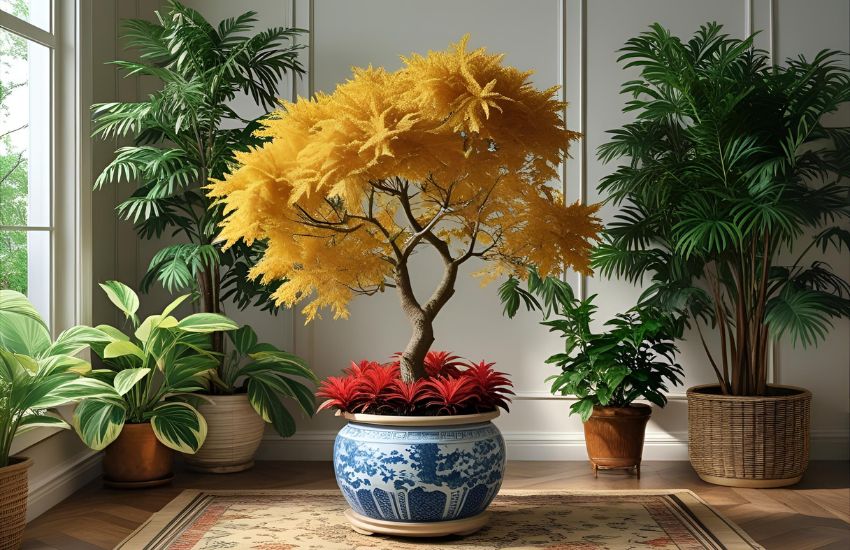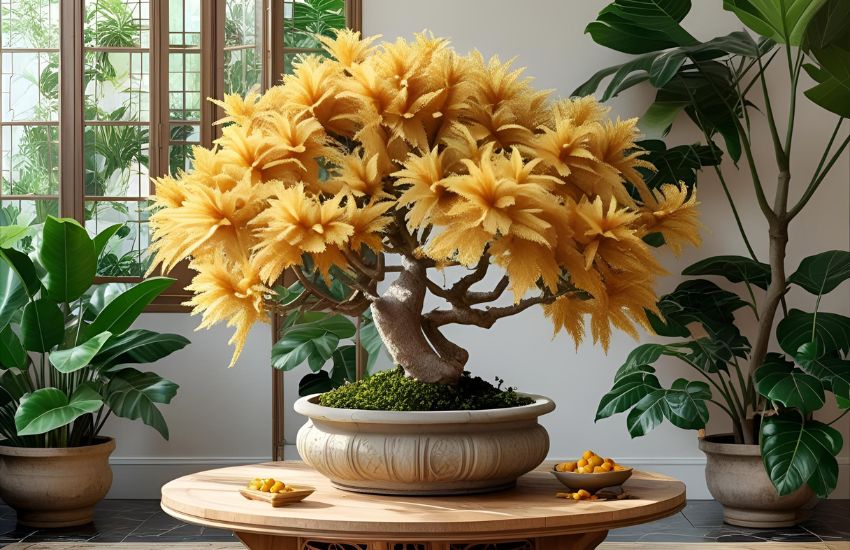Looking to elevate your indoor gardening game with a plant that adds elegance and lush greenery to your space? The Aralia Golden, especially the striking Sun King and Ming Aralia varieties, offers bold foliage and a refined aesthetic that make it a standout houseplant. But to keep these foliage plants thriving, you’ll need to understand their specific care needs—from light and soil to pruning and pest control.
Aralia Golden plants, including Sun King and Ming Aralia, thrive in bright, indirect light with well-draining potting soil. Keep the soil slightly moist but not soggy, and reduce watering in winter. Maintain warm temperatures and moderate humidity. Fertilize monthly during the growing season with a balanced, slow-release fertilizer. Prune lightly to encourage bushier growth.
In this post, you’ll discover how to care for various types of aralias, choose the right pot and fertilizer, manage common problems like pest damage, and understand the proper techniques to prune, repot, and propagate your Aralia Golden for optimal growth.
Essential Aralia Golden Plant Care Tips: Potting, Fertilizer, and Proper Watering

- Choose a pot with good drainage to prevent water buildup and reduce the risk of root rot, a common problem for the aralia golden and ming aralia.
- Use a well-drained, loamy soil mix that retains moisture but doesn’t become waterlogged—ideal for aralias grown indoors.
- During the active growing season, feed your aralia plant monthly with a balanced, slow-release fertilizer to encourage lush, healthy growth.
- Water when the top inch of soil feels dry, and always allow excess moisture to drain fully to avoid soggy roots that could cause leaf drop.
- Avoid placing your golden aralia or Sun King in direct sun; too much exposure can scorch its delicate golden leaves. These plants prefer part sun, light shade, or bright indirect light for best results.
- The Sun King and ming aralia thrive as foliage plants and benefit from consistent moisture, but the soil should never be soggy.
- Repot your plant every 1–2 years, or when root-bound, using a pot that accommodates growth and maintains well draining soil conditions.
- For best results in indoor gardening, monitor humidity levels and consider techniques to increase humidity, especially in dry indoor environments.
- These aralias, including varieties like aralia cordata and japanese spikenard, are often prized as perennial plants in a shade garden, but they can also thrive inside with the proper plant care.
Common Problems with Aralias: Pests, Repotting, and Foliage Fixes

Aralias are generally low-maintenance plants, but like any houseplant, they can face occasional setbacks. Whether you’re growing a lush foliage variety or experimenting with a bonsai version of the aralia, recognizing and responding to issues early will help maintain its beauty and health. Here’s how to handle the most common challenges with confidence and clarity.
Pest Infestations: Prevention and Treatment
Pests like spider mites, aphids, and mealybugs can become a problem, especially in dry conditions with low airflow. You might notice leaf yellowing, webbing, or stunted growth. As part of your proper care routine, inspect the foliage regularly, especially under leaves. If pests appear, apply neem oil as a natural treatment—it’s effective, non-toxic, and safe for indoor use. Also, increasing higher humidity levels can help deter these pests, as aralias prefer a more humid environment.
Repotting Stress and Root Issues
As your aralia grows, it may begin to outgrow its current container, leading to root crowding, stunted growth, or dropped leaves. Always use a pot with good drainage and check if the soil is dry too frequently—this is a common sign it’s time to repot. Aralias prefer moist but well-drained conditions, and deep loamy soil that prefers richly organic matter is ideal. Repot during spring using fresh soil, and avoid disturbing the root ball excessively to reduce stress.
Leaf Discoloration and Foliage Problems
Brown, crispy edges or yellowing leaves may indicate too much sun exposure or incorrect watering. Aralias can tolerate morning sun, but you should avoid direct sunlight in the afternoon as it can scorch their delicate foliage. These plants thrive in medium to bright indirect light, and should be kept in temperatures around 18°C or warmer. Placing your pot on a pebble tray with water underneath can help raise local humidity and support healthy leaves.
If leaves still drop or look unhealthy despite changes, consider whether your plant is in full shade or near air drafts—both can cause stress. Aralias, especially outdoor varieties like hosta companions, typically die back in winter, but this is natural for some species. Indoors, however, healthy foliage year-round is expected.
Propagation as a Recovery Method
If your aralia has suffered severe damage or is aging, consider taking a cutting to propagate a new plant. Use sterilized shears to trim a healthy stem, and root it in water or soil. This method not only gives you a fresh start but also allows you to save a cherished plant that’s declining beyond recovery.
Conclusion
Caring for the aralia golden, Sun King, and ming aralia is a rewarding experience that brings texture, color, and elegance to your indoor space. With thoughtful attention to proper potting soil, release fertilizer, and humidity needs—like misting the leaves—your aralia will thrive and grow bushier over time. These stunning foliage plants can also produce tiny white flowers and inedible berries in ideal conditions, which may deepen into a deep purplish black hue, adding ornamental interest alongside their vibrant foliage.
Keep your plant in temperatures between 60°F and 65°F, avoid overwatering, and monitor for pests like mealybug, which can be managed naturally and effectively. Remember, aralias are not pet-safe—so keep them out of reach of dogs and cats. And if your plant begins to show signs of aging or stress, don’t hesitate to take cuttings and start fresh with healthy growth.
Whether you’re just beginning or refining your indoor gardening skills, the key to success lies in consistent, knowledgeable care.
Frequently Asked Questions (Aralia Golden Plant Care Tips for Sun King and Ming Aralia)
How do you care for Golden Ming Aralia?
Golden Ming Aralia thrives in bright, indirect light and well-draining soil. Keep the soil consistently moist but not waterlogged, watering when the top inch feels dry. Maintain humidity and temperatures between 60–85°F. Fertilize monthly during the growing season with a balanced liquid fertilizer. Prune regularly to maintain shape and encourage bushier growth.
How do you care for golden Aralia?
Golden Aralia thrives in bright, indirect light and well-draining soil. Water moderately, keeping the soil slightly moist but never soggy. Maintain humidity and keep temperatures between 65–85°F. Fertilize monthly during the growing season with a balanced liquid fertilizer. Prune regularly to maintain shape and remove dead leaves for healthier, bushier growth.
Does Ming Aralia need sunlight?
Yes, Ming Aralia needs bright, indirect sunlight to thrive. Direct sunlight can scorch its delicate leaves, while too little light may cause slow growth or leaf drop. Place it near a bright window with filtered light. It can also adapt to moderate light conditions but grows best in consistent, well-lit indoor spaces.
How do you care for Aralia indoors?
To care for Aralia indoors, place it in bright, indirect light and maintain a warm temperature between 65–75°F. Keep the soil consistently moist but not waterlogged, and mist the leaves to maintain humidity. Fertilize monthly during the growing season. Prune regularly to maintain shape and remove dead leaves for healthy growth.
